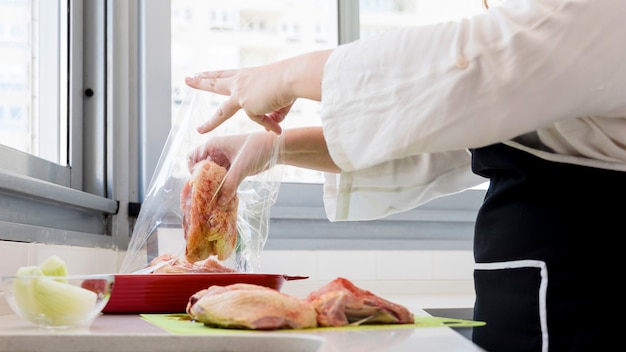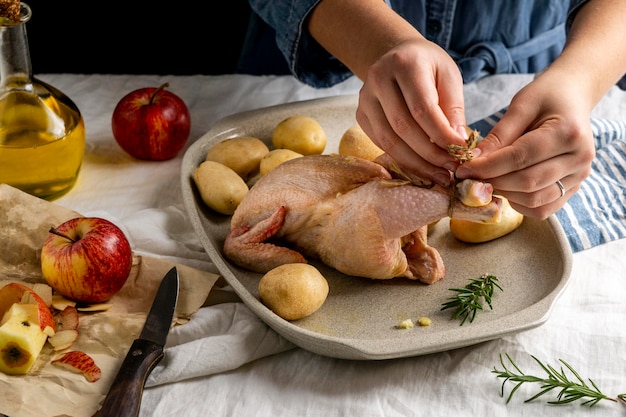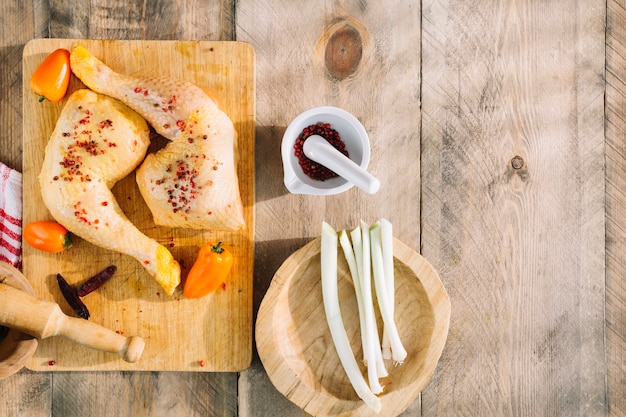Chicken. It's a culinary staple, a versatile ingredient, and a source of endless delicious possibilities. But it can also be a bit of a worry for home cooks. After all, we've all heard the stories: undercooked chicken, food poisoning, and a whole lot of unpleasantness. I've certainly had my share of chicken mishaps in the past - there was that time I served slightly pink chicken at a dinner party, and the time I got a bit too enthusiastic with the grilling and ended up with a rather charred bird. But through trial and error, I've learned a thing or two about cooking chicken safely, and I want to share my knowledge with you.
The key to safe chicken cooking is understanding the importance of internal temperature. That's right, it's not just about making sure it's browned on the outside, it's about reaching a specific temperature inside that kills off harmful bacteria. It might seem a bit technical, but I promise, it's really not that complicated. Let me break it down for you, step-by-step, so you can cook delicious and safe chicken dishes every time.
Part 1: The Science Behind Safe Temperatures

It all boils down to those pesky bacteria that can lurk in raw chicken. Think Salmonella and Campylobacter - the culprits behind those nasty food poisoning episodes that no one wants to experience. They can cause a whole range of unpleasant symptoms, from stomach cramps and diarrhoea to fever and chills. No thank you!
The good news is that these bacteria are killed off when the chicken reaches a safe internal temperature. The magic number? 165°F (74°C). Yes, you read that right! It needs to be cooked thoroughly, all the way through, to ensure those bacteria are eliminated. This applies to all parts of the chicken, whether it's juicy breasts, succulent thighs, or even those delightful little wings.
Why Temperature Matters: Beyond Bacteria
You might be thinking, "Okay, I get the bacteria part, but why is temperature so important for taste and texture?" Good question! Cooking chicken to the right temperature doesn't just make it safe, it also helps to achieve the perfect texture and flavour.
Imagine this: You’ve spent all day preparing a beautiful roast chicken, only to find that it’s dry and tough. The culprit? Overcooking! Cooking chicken beyond 165°F (74°C) can lead to dryness and toughness. On the other hand, if you undercook it, the risk of food poisoning is real, and you might also end up with a chicken that's raw in the middle, which is definitely not a pleasant experience.
Part 2: The Essential Tool: Your meat thermometer

So, how do you know if your chicken has reached that crucial 165°F (74°C) mark? This is where your trusty meat thermometer comes in. It’s the hero of the kitchen, the one who ensures your chicken is cooked to perfection and safe to eat. I recommend a digital meat thermometer, as they're fast, accurate, and easy to use. Forget those old-fashioned candy thermometers, we're going high-tech here!
You can find digital meat thermometers at most kitchen stores and supermarkets. Look for one with a needle or probe that you can insert into the thickest part of the chicken. Avoid touching any bones, as they can give you a false reading. Just insert the probe, wait a few seconds for the reading to stabilize, and voila! You’ve got your answer.
Using Your Meat Thermometer Like a Pro
Here are some tips for using your meat thermometer like a pro:
- Insert the probe into the thickest part of the chicken, avoiding any bones.
- Leave it in for a few seconds until the temperature reading stabilizes.
- If the temperature is below 165°F (74°C), continue cooking the chicken until it reaches the desired temperature.
- Always use a clean thermometer and wash it thoroughly after each use.
Part 3: Cooking Methods and Temperature Tips

Let's dive into the specifics of cooking chicken using different methods. Each technique has its own nuances and tricks to ensure your chicken reaches that all-important 165°F (74°C) mark.
Roasting: A Timeless Classic
roasting chicken is a timeless classic, perfect for a Sunday dinner or a special occasion. It's a simple method, but it does require some attention to detail to ensure the chicken cooks evenly. Preheat your oven to 375°F (190°C) – this is crucial for achieving a crispy skin and juicy meat. Place the chicken on a roasting rack in a baking pan, allowing air to circulate around the bird for even cooking. And of course, check the temperature in the thickest part of the thigh using your trusty meat thermometer. Don't forget to let the chicken rest for 10 minutes before carving, allowing the juices to redistribute and resulting in a more succulent bird.
Grilling: A Summertime Favourite
grilling chicken is a summertime favourite, perfect for enjoying on the patio or by the pool. The key to grilling chicken safely is to use medium heat and ensure your grill grates are clean. Position the chicken over indirect heat, allowing it to cook slowly and evenly. You can use a grilling thermometer, but remember to always check the internal temperature of the thickest part of the chicken. Grilling time will vary depending on the size and thickness of the pieces, so keep an eye on it and use your thermometer. Remember, it's always better to err on the side of caution and overcook slightly than undercook.
Pan-Frying: Quick and Delicious
Pan-frying is a quick and easy way to cook chicken breasts or thighs, perfect for a weeknight dinner. Heat a good amount of oil in a skillet over medium-high heat. Add the chicken pieces, making sure they're not overcrowded in the skillet. Cook for about 5-7 minutes per side, or until golden brown and cooked through. Use your meat thermometer to check the internal temperature, ensuring it reaches 165°F (74°C). Let the chicken rest for a few minutes before serving, allowing the juices to redistribute and resulting in a more tender and flavorful dish.
Boiling: A Simple But Versatile Technique
Boiling is a basic cooking method often used for soups, stews, and stocks. Bring a pot of salted water to a rolling boil. Add the chicken pieces and reduce the heat to a simmer. Cook for 15-20 minutes, or until the chicken is cooked through. Use your meat thermometer to confirm the internal temperature has reached 165°F (74°C). Once cooked, remove the chicken from the pot and shred or chop as needed.
Part 4: chicken safety: Beyond Temperature
While internal temperature is crucial, there are other important aspects to safe chicken handling and cooking. Let's explore some key points to remember.
Safe Handling: The Basics
It all starts with handling chicken responsibly. Here are some key points to remember:
- Wash your hands thoroughly with soap and water for at least 20 seconds before and after handling raw chicken.
- Don't cross-contaminate other foods. Use separate cutting boards and utensils for raw chicken and other foods.
- Wash all surfaces and utensils that have come into contact with raw chicken with hot soapy water.
- Store raw chicken in the refrigerator below 40°F (4°C). Never leave raw chicken out at room temperature for more than 2 hours.
- Always cook chicken thoroughly to an internal temperature of 165°F (74°C).
Choosing the Right Chicken: What to Look For
When choosing chicken at the supermarket, look for these signs of freshness and quality:
- Fresh chicken should be firm and springy to the touch.
- The packaging should be intact and not leaking.
- The colour of the chicken should be a uniform pale pink or white.
- Avoid buying chicken with a strong odour or discoloration.
Part 5: chicken recipes to Delight Your Taste Buds
Now that you know the safety basics, let's get inspired with some delicious chicken recipes! Here are a few favourites that are both safe and incredibly tasty.
Easy Roasted Chicken with Lemon and Herbs: A Classic for a Reason
This is a classic and simple roasted chicken recipe that's always a crowd-pleaser. Here's what you'll need:
- 1 whole chicken (about 3-4 lbs)
- 2 lemons, halved
- 2 tablespoons olive oil
- 2 tablespoons chopped fresh herbs (such as rosemary, thyme, and parsley)
- Salt and pepper to taste
Preheat the oven to 375°F (190°C). Rinse the chicken and pat it dry with paper towels. Stuff the lemon halves and herbs into the chicken cavity. Rub the chicken with olive oil, salt, and pepper. Place the chicken on a roasting rack in a baking pan. Roast for 1 hour and 15 minutes, or until the internal temperature reaches 165°F (74°C). Let the chicken rest for 10 minutes before carving.
grilled chicken Skewers with Mango Salsa: Summertime Perfection
These grilled chicken skewers are perfect for a summer barbecue, bringing a taste of the tropics to your table. Here's what you'll need:
- 1 pound boneless, skinless chicken breasts, cut into 1-inch cubes
- 1 tablespoon olive oil
- 1/2 teaspoon salt
- 1/4 teaspoon black pepper
- 12 wooden skewers, soaked in water for 30 minutes
For the mango salsa:
- 1 ripe mango, diced
- 1/2 red onion, diced
- 1/4 cup chopped fresh cilantro
- 2 tablespoons lime juice
- 1/4 teaspoon salt
- 1/8 teaspoon black pepper
Preheat the grill to medium heat. In a bowl, combine the chicken, olive oil, salt, and pepper. Thread the chicken cubes onto the skewers. Grill the skewers for 8-10 minutes, turning occasionally, or until the chicken is cooked through and reaches 165°F (74°C). Meanwhile, combine the mango salsa ingredients in a bowl and set aside. Serve the grilled chicken skewers with the mango salsa.
Creamy Chicken and Mushroom Pasta: comfort food at Its Best
This creamy chicken and mushroom pasta dish is comforting and satisfying, perfect for a cozy evening meal. Here's what you'll need:
- 1 pound boneless, skinless chicken breasts, cut into bite-sized pieces
- 1 tablespoon olive oil
- 1/2 onion, chopped
- 2 cloves garlic, minced
- 1 pound cremini mushrooms, sliced
- 1/2 cup chicken broth
- 1/2 cup heavy cream
- 1/4 cup grated Parmesan cheese
- 1/4 teaspoon salt
- 1/8 teaspoon black pepper
- 1 pound pasta, cooked according to package directions
- Chopped fresh parsley, for garnish (optional)
In a large skillet, heat olive oil over medium heat. Add chicken and cook until browned on all sides. Remove chicken from the skillet and set aside. Add onion and garlic to the skillet and cook until softened. Add mushrooms and cook until golden brown. Pour in chicken broth and bring to a simmer. Stir in heavy cream, Parmesan cheese, salt, and pepper. Return chicken to the skillet and heat through. Add cooked pasta and stir to combine. Garnish with chopped parsley and serve immediately.
Part 6: Chicken Storage: The Do’s and Don’ts
Once you've cooked those delicious chicken dishes, it's crucial to store them properly to ensure they stay safe and tasty. Here are some tips to remember:
- Refrigerate cooked chicken within 2 hours of cooking.
- Store cooked chicken in an airtight container in the refrigerator.
- Cooked chicken can be stored in the refrigerator for 3-4 days.
- To freeze cooked chicken, place it in an airtight container or freezer-safe bag.
- Frozen cooked chicken can be stored for up to 2-3 months.
- When reheating cooked chicken, ensure it reaches an internal temperature of 165°F (74°C).
Part 7: Decoding food safety Labels
Ever noticed those food safety labels on chicken packaging? They can be a bit confusing, so let's break them down together.
The "Use By" Date
This date is a guideline for the best quality of the chicken. After this date, the chicken may start to lose its quality and taste, but it's not necessarily unsafe to eat. However, it's best to follow the "Use By" date for optimal freshness.
The "Sell By" Date
This date is for the grocery store's guidance on when to remove the chicken from the shelves. It doesn't necessarily mean the chicken is unsafe to eat after this date.
The "Keep Refrigerated" Label
This label simply means that the chicken should be kept refrigerated at or below 40°F (4°C).
Part 8: Common Chicken Mistakes to Avoid
Let's talk about some common mistakes that people make when cooking chicken, and how to avoid them.
Undercooking Chicken: The Biggest Mistake
The most common mistake is undercooking chicken. Always check the internal temperature to ensure it has reached 165°F (74°C). Never rely on the colour of the chicken alone, as it can be deceiving.
Cross-Contamination: Preventing the Spread of Bacteria
This is another crucial point to remember. Always use separate cutting boards and utensils for raw chicken and other foods to prevent cross-contamination.
Leaving Chicken Out Too Long: A Recipe for Disaster
Raw chicken should never be left out at room temperature for more than 2 hours. Bacteria can multiply rapidly at room temperature, increasing the risk of food poisoning.
Part 9: FAQs: Your Chicken Questions Answered
Let's answer some common questions about chicken safety.
1. Can I wash raw chicken before cooking it?
This is a big no-no! Washing raw chicken can actually spread bacteria around your sink and kitchen, increasing the risk of cross-contamination. Instead, just pat the chicken dry with paper towels.
2. Can I eat chicken that’s still pink inside?
Absolutely not! The colour of the chicken can be deceiving. The only way to know for sure if the chicken is cooked through is to check the internal temperature with a meat thermometer.
3. Can I refreeze chicken that has been thawed?
It’s not recommended to refreeze chicken that has been thawed. Thawing and refreezing can compromise the quality and safety of the chicken. It’s best to cook thawed chicken immediately.
4. Is it safe to eat chicken that’s been sitting out for a few hours?
Not if it’s been at room temperature for more than 2 hours. Bacteria can grow rapidly at room temperature, increasing the risk of food poisoning. If the chicken has been out for longer than 2 hours, it’s best to throw it away.
5. What are some signs of food poisoning?
Symptoms of food poisoning can include nausea, vomiting, diarrhea, abdominal cramps, fever, and chills. If you experience any of these symptoms after eating chicken, it’s important to seek medical attention.
Final Thoughts
Cooking chicken safely is about understanding the science behind it, taking the right precautions, and using your trusty tools, like your meat thermometer. By following these tips, you can enjoy delicious and safe chicken dishes every time. So, don't be afraid to get in the kitchen and start experimenting! And remember, when in doubt, always check the internal temperature with a meat thermometer. Safe and happy cooking!
Everyone is watching

Corn on the Cob: The Ultimate Guide to Perfectly Cooked Ears
Healthy MealsAh, corn on the cob. Just the name evokes images of sunny days, barbecues, and that sweet, juicy flavour that ...

Perfect Pork Roast Oven Cooking Time: A Guide to Delicious Results
Healthy MealsThere's something truly satisfying about a perfectly roasted pork. The aroma alone is enough to make your mout...

Ham Cooking Time: How Long to Bake, Smoke, or Boil a Delicious Ham
Healthy MealsAh, ham. It's a classic, isn't it? A real crowd-pleaser, especially around holidays. And when done right, it'...

Scallops: The Ultimate Guide to Perfect Cooking
Healthy MealsAh, scallops. Those delicate, sweet, and utterly delicious morsels of the sea. They hold a special place in my...

Spaghetti Squash: The Ultimate Guide to Cooking and Serving
Healthy MealsRemember that time you saw spaghetti squash at the supermarket, looking all bumpy and strange, and thought, "W...
